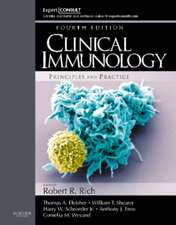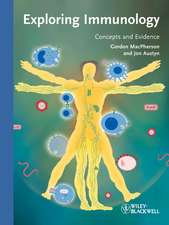Immunochemistry of Proteins: Volume 2
Editat de M. Atassien Limba Engleză Paperback – 9 oct 2011
Preț: 378.07 lei
Preț vechi: 397.97 lei
-5% Nou
Puncte Express: 567
Preț estimativ în valută:
72.34€ • 75.94$ • 60.05£
72.34€ • 75.94$ • 60.05£
Carte tipărită la comandă
Livrare economică 11-25 aprilie
Preluare comenzi: 021 569.72.76
Specificații
ISBN-13: 9781461341956
ISBN-10: 1461341957
Pagini: 464
Ilustrații: XX, 438 p.
Dimensiuni: 155 x 235 x 24 mm
Greutate: 0.65 kg
Ediția:Softcover reprint of the original 1st ed. 1977
Editura: Springer Us
Colecția Springer
Locul publicării:New York, NY, United States
ISBN-10: 1461341957
Pagini: 464
Ilustrații: XX, 438 p.
Dimensiuni: 155 x 235 x 24 mm
Greutate: 0.65 kg
Ediția:Softcover reprint of the original 1st ed. 1977
Editura: Springer Us
Colecția Springer
Locul publicării:New York, NY, United States
Public țintă
ResearchCuprins
1 Affinity Chromatography in Immunology.- I. Introduction.- II. Selection of Matrix.- III. Chemistry of Immobilization.- IV. Elution Techniques.- V. Purification of Antigens.- VI. Purification of Antibodies.- VII. Separation of Cell Populations.- VIII. Reversed Affinity Chromatography.- IX. Miscellaneous Applications.- X. References.- 2 The Effect of Antigen Structure on Preferential Humoral or Cellular Immunogenicity.- I. Introduction.- II. Antigenic Specificity.- III. Immune Induction.- IV. The Effect of Determinant Valency.- V. References.- 3 The Complete Antigenic Structure of Myoglobin: Approaches and Conclusions for Antigenic Structures of Proteins.- I. Introduction.- II. Strategy of Approach.- III. Accurate Assignment of the Reactive Regions.- IV. Contribution of the Reactive Regions to the Total Immune Reaction of Myoglobin and Immunochemical Independence of the Regions.- V. In Vitro Studies with the Synthetic Regions.- VI. Immunochemical Relationship of Myoglobins and Nature of Immunochemical Cross-Reactions of Proteins.- VII. Conclusions.- VIII. References.- 4 The Antigenic Structure of Hen Egg-White Lysozyme: A Model for Disulfide-Containing Proteins.- I. Introduction.- II. Immunochemistry and Conformation of Lysozyme Derivatives with Broken Disulfide Bonds.- III. Immunochemistry and Conformation of Specific Chemical Derivatives of Lysozyme.- IV. Immunochemistry of Peptide Fragments.- V. Specific Chemical Derivatives of Immunochemically Reactive Reactive Peptides.- VI. Peptide Synthesis for Final Delineation of Antigenic Sites..- VII. Accurate Assignment of the Antigenic Sites.- VIII. Immunochemistry of Lysozymes from Various Species and Other Closely Related Proteins.- IX. Conclusions.- X. References.- 5 Immunochemistry of the Tobacco Mosaic Virus Protein.-I. Introduction.- II. The Relationship between Antigenic Structure and Binding with Antibodies.- III. The Relationship between Antigenic Structure and Cell-Mediated Immunity.- IV. The Relationship between Structure and Immunogenicity.- V. The Genetic Control of the Immune Responsiveness to Antigenic Areas of TMVP.- VI. Concluding Remarks.- VII. References.- 6 Immunochemistry of Protein Mutants.- I. Introduction.- II. Immunochemical Detection of Single Amino Acid Differences in Proteins.- III. Relationship of Immunogenicity to Single Amino Acid Differences in Proteins.- IV. Isolation of Antibodies Sensitive to Single Amino Acid Differences in Protein Antigens.- V. Fractionation of an Antibody Response by Methods Other Than Immunoadsorbents Related to Single Amino Acid Differences.- VI. Speculations on the Relationship of Protein Antigenicity and Antigen Receptors on T and B Cells.- VII. References.- 7 Evolution of the Immunogenic and Subunit Interaction Sites of Oligomeric Enzymes.- I. Introduction.- II. Theoretical Considerations on the Evolution of Enzymes.- III. Experimental Examples.- IV. Concluding Remarks and Prognosis.- V. References.- 8 The Structure and Activity of Concanavalin A.- I. Introduction and Biological Properties.- II. Carbohydrate Binding Specificity.- III. Chemical Modification Studies.- IV. Three-Dimensional Structure.- V. References.- Author Index.






